

katelyn
Yarn bombing. WebCrawler Web Search. WW100 New Zealand. Pigeon post. Pigeons with messages attached.
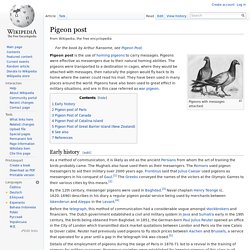
Pigeon post is the use of homing pigeons to carry messages. Pigeons were effective as messengers due to their natural homing abilities. The pigeons were transported to a destination in cages, where they would be attached with messages, then naturally the pigeon would fly back to its home where the owner could read his mail. 21 Amazing Facts About Pigeons - PCRC. Table of Contents 1.

Animals at war: Dolphins, dogs, elephants, glow worms, and carrier pigeons. Animals In War Memorial - History - information about animals served in war. The British, Commonwealth and Allied forces enlisted many millions of animals to serve and often die alongside their armies.

These animals were chosen for a variety of their natural instincts and vast numbers were killed, often suffering agonising deaths from wounds, starvation, thirst, exhaustion, disease and exposure. Horses, Mules and Donkeys Eight million horses and countless mules and donkeys died in the First World War. Remembering the horses of World War 1. This image of shire horse Hercules was released by Hurst Green Shires on the 100th anniversary of the declaration of World War 1.
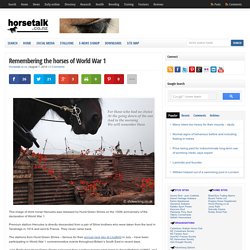
Premium stallion Hercules is directly descended from a pair of Shire brothers who were taken from the land in Tandridge in 1914 and sent to France. They never came back. The stallions from Hurst Green Shires – famous for their annual race day at Lingfield in July – have been participating in World War 1 commemorative events throughout Britain’s South East in recent days. Julie Reilly from Hurst Green Shires said more than a million horses were taken to the battlefields of WW1, and it is estimated that 65 to 75 percent did not return.
PIGEON FACTS YOU MIGHT NOT KNOW. Animals In War Memorial - The Animals In War Memorial - Park Lane, London. The Anzac landing at Gallipoli. The Anzac landing: overview Why did theAnzacs land?
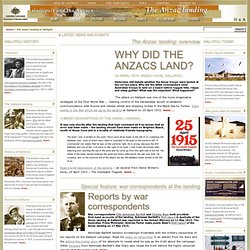
25 April 1915: Anzac Cove, Gallipoli Historians still debate whether the Anzac troops were landed at the correct place. Why did the Allied commanders send Australian troops to land on a beach before rugged hills, ridges and steep gullies? Among Our WWI Heroes: A Pigeon named Cher Ami. It’s one of the most incredible and enduring stories of World War One.
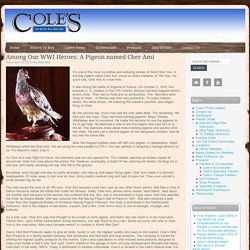
A homing pigeon called Cher Ami saved an entire battalion of 194 men. As you’ll see, Cher Ami is a true hero. It was during the battle of Argonne in France. On October 3, 1918, five hundred U. S. soldiers in the 77th Infantry Division became trapped behind enemy lines. World War I in Photos: Animals at War. Carrier Pigeons Used During World War I. Carrier Pigeons, used to carry communications during World War I, proved to be instrumental in the war.
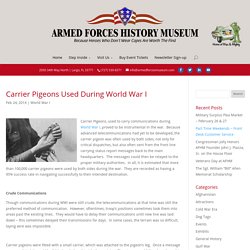
Because advanced telecommunications had yet to be developed, the carrier pigeon was often used by both sides, not only for critical dispatches, but also often sent from the front line carrying status report messages back to the main headquarters. The messages could then be relayed to the proper military authorities. In all, it is estimated that more than 100,000 carrier pigeons were used by both sides during the war. They are recorded as having a 95% success rate in navigating successfully to their intended destination. Crude Communications Though communications during WWI were still crude, the telecommunications at that time was still the preferred method of communication. Pigeons - Everything there is to know about the pigeon - PCRC. Table of Contents Latin Name: Columba livia (‘dove’ or ‘bird of leaden or blue-grey colour’).

Common Names: Pigeon, dove, blue rock pigeon, rock dove, wild rock pigeon, rock pigeon, feral pigeon. 15 Animals That Went To War. History of War Animals. War pigeon. British WW1 poster regarding the killing of war pigeons being an offence under Regulation 21A of the Defence of the Realm Act Pigeons have long played an important role in war.
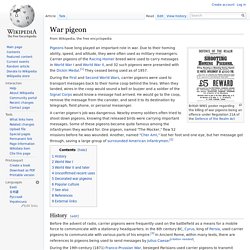
Due to their homing ability, speed, and altitude, they were often used as military messengers. Carrier pigeons of the Racing Homer breed were used to carry messages in World War I and World War II, and 32 such pigeons were presented with the Dickin Medal.[1] They ceased being used as of 1957. During the First and Second World Wars, carrier pigeons were used to transport messages back to their home coop behind the lines. When they landed, wires in the coop would sound a bell or buzzer and a soldier of the Signal Corps would know a message had arrived. History[edit] Before the advent of radio, carrier pigeons were frequently used on the battlefield as a means for a mobile force to communicate with a stationary headquarters.
Pigeons and World War One - History Learning Site. Pigeons played a vital part in World War One as they proved to be an extremely reliable way of sending messages.
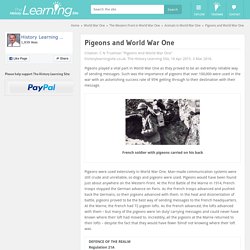
Such was the importance of pigeons that over 100,000 were used in the war with an astonishing success rate of 95% getting through to their destination with their message. Pigeons were used extensively in World War One. Man-made communication systems were still crude and unreliable, so dogs and pigeons were used. Pigeons would have been found just about anywhere on the Western Front. Facts and information about pigeons. Pigeons are incredibly complex and intelligent animals. They are one of only a small number of species to pass the ‘mirror test’ – a test of self recognition. Pigeons are incredibly complex and intelligent animals. They are one of only a small number of species to pass the ‘mirror test’ – a test of self recognition. They can also recognise each letter of the human alphabet, differentiate between photographs, and even distinguish different humans within a photograph. Encyclopedia Smithsonian: Cher Ami. Cher Ami (click to zoom) "Cher Ami" was a registered Black Check Cock carrier pigeon, one of 600 birds owned and flown by the U.S.
Army Signal Corps in France during World War I. He delivered 12 important messages within the American sector at Verdun, France. On his last mission, "Cher Ami," shot through the breast by enemy fire, managed to return to his loft. A message capsule was found dangling from the ligaments of one of his legs that also had been shattered by enemy fire. Cher Ami. World War I service[edit] On October 3, 1918, Major Charles Whittlesey and more than 500 men were trapped in a small depression on the side of the hill behind enemy lines without food or ammunition. They were also beginning to receive friendly fire from allied troops who did not know their location. Surrounded by the Germans, many were killed and wounded in the first day and by the second day, just over 190[verification needed] men were still alive. Cher Ami - The Carrier Pigeon who saved 200 men.